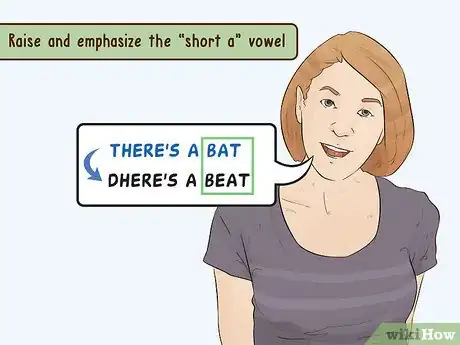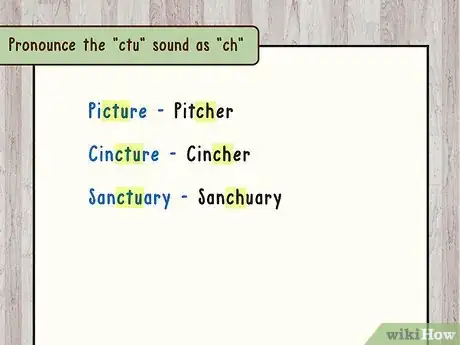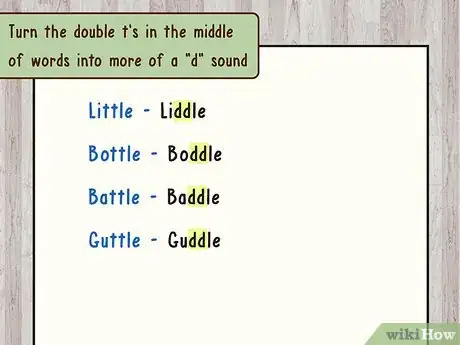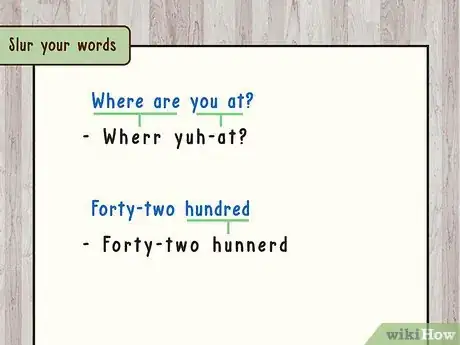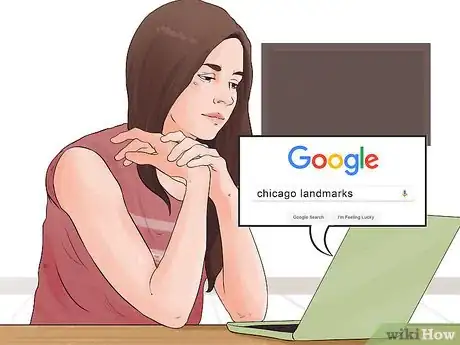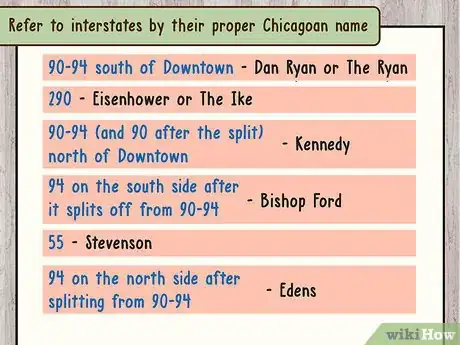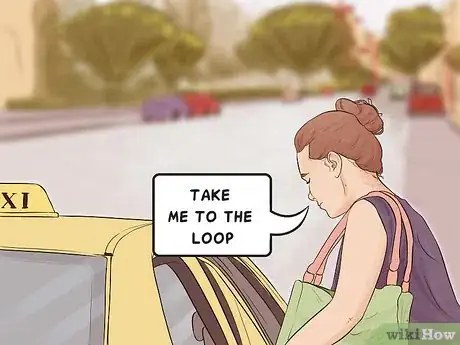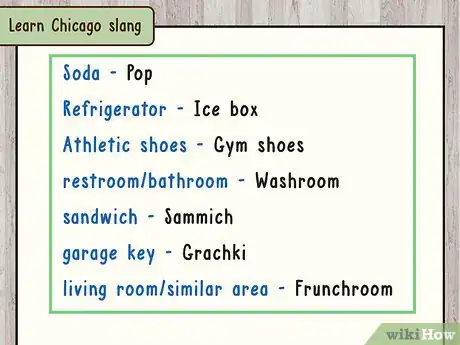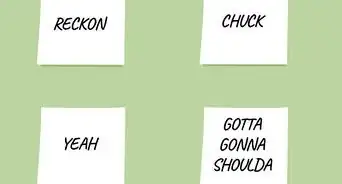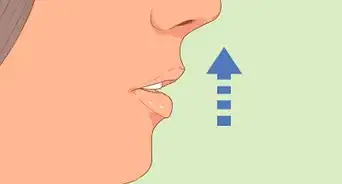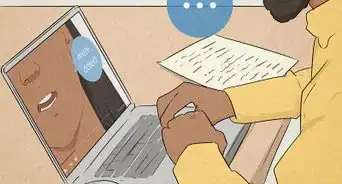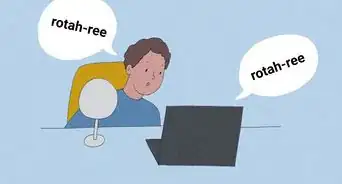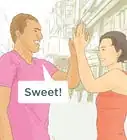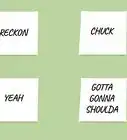This article was co-authored by wikiHow Staff. Our trained team of editors and researchers validate articles for accuracy and comprehensiveness. wikiHow's Content Management Team carefully monitors the work from our editorial staff to ensure that each article is backed by trusted research and meets our high quality standards.
This article has been viewed 815,810 times.
Learn more...
Whether you're an actor preparing for a role or a newcomer to the city looking to fit in, you might find it useful to learn how to replicate the Chicago accent. While the accent varies throughout the city, there are a few key elements you might want to learn. You'll need to learn how Chicagoans pronounce their vowels and consonants, as well as their specific lingo.
Steps
Tweaking Vowels and Consonants
-
1Raise and emphasize the “short a” vowel. This is the vowel you'll find in words such as bat and cat. Chicagoans pronounce this vowel with their tongue closer to their teeth and higher in their mouth.[1] With this pronunciation, a word like “bat” ends up sounding more like “beat.”
-
2Turn the “short o” vowel into the “short a.” As the short a turns into a different vowel, the short o comes into replace it. This turns “hot” into “hat” and “pop” into “pap.”[2] You don't want to exaggerate this shift too much; look up Chicagoans speaking on YouTube to understand the subtlety of this shift.Advertisement
-
3Shift the pronunciation of the “short u.” With this shift, words like “but” and “cut” sound more like “bought” and “caught.”[3] This is the last of the main three vowels most Chicagoans shift; they are the most recognizable differences in this accent.
- Learning these three vowel shifts will give you a more universal sounding Chicago accent.
- Other variations on the pronunciation of vowels vary depending on specific neighborhoods within the city.
-
4Pronounce the “th” sound more like a “d.” You don't necessarily want to use a hard “d” like in the famous Superfans Saturday Night Live sketch. You want the resulting sound to end up somewhere between how you would usually say a “th” and a “d.” The trick is in the placement of your tongue. With a regular “th” sound, your tongue is placed between your teeth as you begin saying it. With the Chicagoan “th,” your tongue starts behind your teeth, though make sure to still keep your teeth apart.
- For instance, “There's that guy from the office” becomes “Dhere's dat guy from de office.”
-
5Pronounce the "ctu" sound as "ch." The word "picture," for instance, commonly pronounced in Chicago as "pitcher." "Cincture" becomes "cincher," sanctuary becomes "sanchuary," and so on.
-
6Turn the double t's in the middle of words into more of a "d" sound. In other words, "little" and "bottle" become "liddle" and "boddle." Don't exaggerate the pronunciation of the “d,” or you'll start sounding like a parody.
-
7Slur your words. Many Chicagoans slur their words slightly when they speak, letting them run into each other. This is especially true when one word ends with a vowel sound and the next one begins with one as well, though it also occurs with consonant sounds.
- For instance, when saying "Where are you at?", "where" and "are" are blended together so that it sounds like "Wherer," whereas "you" and "at" are contracted to "y'at." All together, this phrase should sound like "Wherr yuh-at?"
- If your answer is "4200 North Pulaski," you say "Forty-two hunnerd," not "Forty-two hundred."
Using Chicago Lingo and Vocabulary
-
1Learn the "correct" names for Chicago landmarks. People from outside of Chicago often share the misconception that various Chicago landmarks and locations' names are those seen on the signs. Real Chicagoans typically substitute their own vernacular for these locations, for instance :
-
2Refer to interstates by their proper Chicagoan name. In Chicago, the large, multi-lane highways for automobiles that are part of the national Interstate Highway System are not, in fact, "interstates." They are instead called expressways or highways. Better yet, call these highways by their honorary Chicago names. See below:
- 90-94 south of Downtown = "Dan Ryan" or "The Ryan."
- 290 = "Eisenhower" or "The Ike."
- 90-94 (and 90 after the split) north of Downtown = "Kennedy."
- 94 on the south side after it splits off from 90-94 = "Bishop Ford"
- 55 = "Stevenson."
- 94 on the north side after splitting from 90-94 = "Edens."
-
3Learn the local names for the different parts of the city. When you're in Chicago, calling a part of the city by its "proper" name can be a dead giveaway that you're not a local. Below are some primary examples of Chicagoan names for different parts of the city:
- The downtown financial district is called "The Loop."
- Anything south of Roosevelt Rd. is called "The South Side," even though this includes more than half of the entire city.
- Conversely, anything north of Division is "The North Side."
-
4Learn Chicago slang. There are many terms and phrases that Chicagoans use that you'll need to know if you want to have a convincing accent. Some of these aren't unique to Chicago, as they are also found in other Northern cities. Here are a few examples:
- “Soda” is known as “Pop.”
- A “refrigerator” is sometimes referred to as an “ice box.”
- Athletic shoes are referred to as “gym shoes” rather than “sneakers.”[6]
Community Q&A
-
QuestionDoes "ask" sound like "axe" in a Chicago accent?
 Community AnswerNo, ask sounds like ask. There are some people in south Chicago who pronounce it "axe," but this is pretty rare.
Community AnswerNo, ask sounds like ask. There are some people in south Chicago who pronounce it "axe," but this is pretty rare. -
QuestionHow do Chicagoans pronounce "Chicago"?
 Sioux Turnoy WarfieldCommunity AnswerHow Chicago is pronounced depends largely on the neighborhood. From the far northside, I say "Chicawgo." The other neighborhoods lean more toward "Chicahgo." Remember that "ch" is always pronounced "sh."
Sioux Turnoy WarfieldCommunity AnswerHow Chicago is pronounced depends largely on the neighborhood. From the far northside, I say "Chicawgo." The other neighborhoods lean more toward "Chicahgo." Remember that "ch" is always pronounced "sh." -
QuestionHow can I tell if someone has a Chicago accent?
 Community AnswerIf they say words like "little" as "liddle" with or if they say things like "By over dhere," they're a Chicagoan.
Community AnswerIf they say words like "little" as "liddle" with or if they say things like "By over dhere," they're a Chicagoan.
References
- ↑ http://www.slate.com/articles/life/the_good_word/2012/08/northern_cities_vowel_shift_how_americans_in_the_great_lakes_region_are_revolutionizing_english_.html
- ↑ https://www.wbez.org/shows/curious-city/chuh-kaw-go-what-do-you-really-sound-like/9054d7a4-f876-4c53-8ce1-08adae048d28
- ↑ https://www.wbez.org/shows/curious-city/chuh-kaw-go-what-do-you-really-sound-like/9054d7a4-f876-4c53-8ce1-08adae048d28
- ↑ http://www.nbcnews.com/id/21693664
- ↑ http://www.chicagotribune.com/sports/baseball/whitesox/ct-white-sox-stadium-guaranteed-rate-20160824-story.html
- ↑ https://www.youtube.com/watch?v=JDCjEpQto9k
About This Article
To fake a Chicago accent, raise and emphasize the “short a” vowel so that words like "bat" sound more like "beat." You can also turn draw out the sound in words with a “short u” like “but” and “cut” to sound more like “bought” and “caught.” When using words with a "th" sound, make it sound more like a hard "d," so the word "that" sounds like "dat." In general, try slurring your words slightly together when you speak so that phrases like "Where are you at?" sound more like "Wherr yuh-at?" To learn how to master some Chicago lingo, scroll down!
